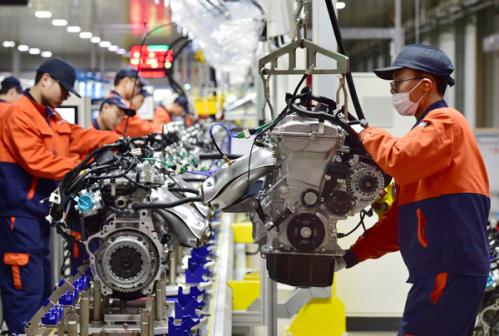
Technical workers assemble engines at a plant in Yiwu, Zhejiang province.[Photo provided for China Daily]
The Chinese economy is expected to remain resilient in the second half, as continued efforts to promote economic transformation will support the economy as it bottoms out, experts said.
China's economy steamed along in the second quarter with 6.9 percent GDP growth, beating market expectations and hovering well above previous institutional forecasts.
"The resilience of the economy can be seen by the relatively high growth rate since the financial crisis back in 2008, but now there is much more to tell behind the headline growth number," said Hu Angang, director of Center for China Studies of Tsinghua University. "We have made continued progress moving away from the old manufacturing model to services-led model."
The International Monetary Fund raised the forecast late on Tuesday for China's average annual growth for 2018-20 to 6.4 percent from 6.0 percent, predicting that China will see robust economic growth, paving the way for policymakers to accelerate needed reforms and focus more on quality growth.
While acknowledging China's effort to deepen reforms and to avoid risks piling up, the IMF contended that China needs to boost consumption as the country's savings rate is twice the global average.
Hu said the rebalancing process of the Chinese economy is expected to continue, with consumption supposed to take a greater share of economic growth in the coming years.
The share of consumption contributing to GDP growth is expected to exceed 70 percent this year, Hu said.
Consumption accounted for 63.4 percent of GDP growth in the first half of 2017, compared with 44.7 percent during the same period in 2010.
He said China is not likely to slip back to the old debt-driven model. Rather, the country needs to press ahead with reforms, such as lowering leverage ratios and preventing financial risks.
"In the coming months, solving problems such as piling up debt might be a more important task for China compared with hitting certain growth targets," he said.
The Chinese economy is drawing support from strong sources of cyclical resilience in early 2017, Stephen Roach, a senior fellow at Yale University, wrote in July, citing the fast growth of exports.
June's 11.3 percent year-on-year gain in exports stands in contrast with earlier years, which were adversely affected by a weaker global recovery, he noted.
Aside from benefiting from global demand recovery, better-than-expected industrial profits will support continued and sustained growth, according to Ren Zeping, chief economist at Founder Securities.
He said the economy is continuing to bottom out, thanks to the ongoing supply-side reform and the weak recovery on the demand side.
According to San Francisco-based SpaceKnow Inc, which uses commercial satellite imagery to monitor over 6,000 industrial facilities across China to measure levels of manufacturing activity, manufacturing picked up in July, with the China Satellite Manufacturing Index up to 50.5 from 49.5 in June, which signals improved conditions.
Meanwhile, activities of small and medium-sized enterprises in China rebounded in July after three straight months of moderation.